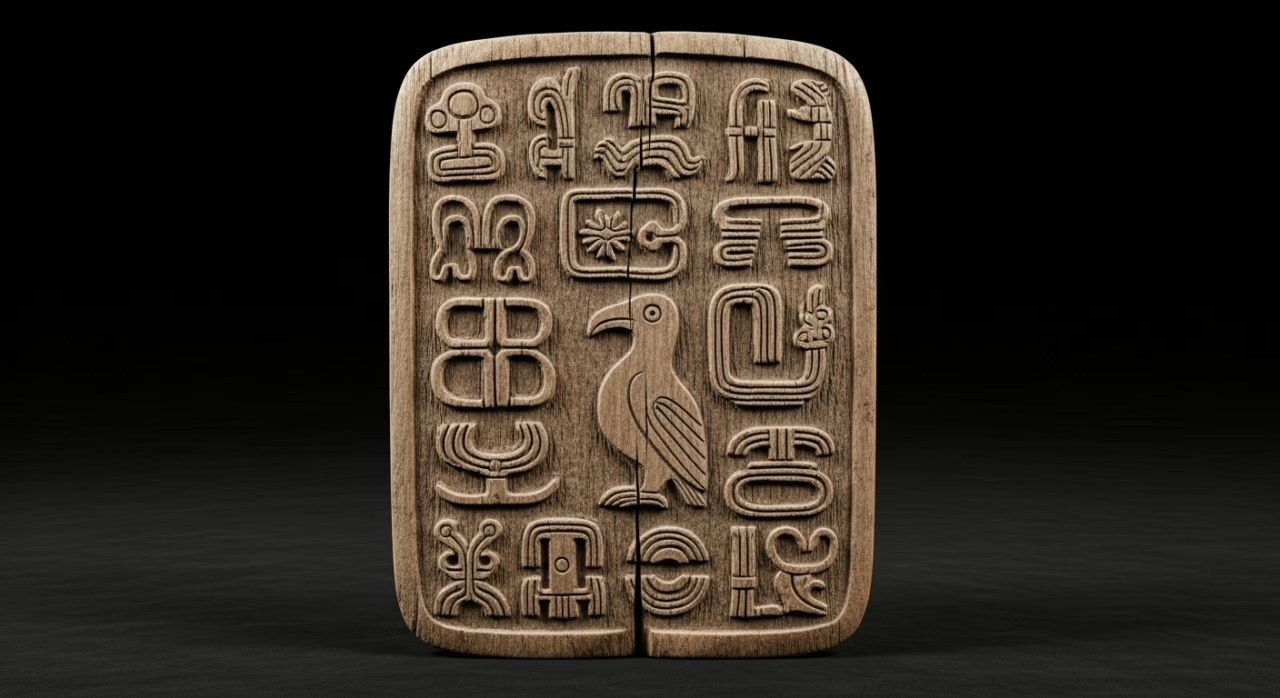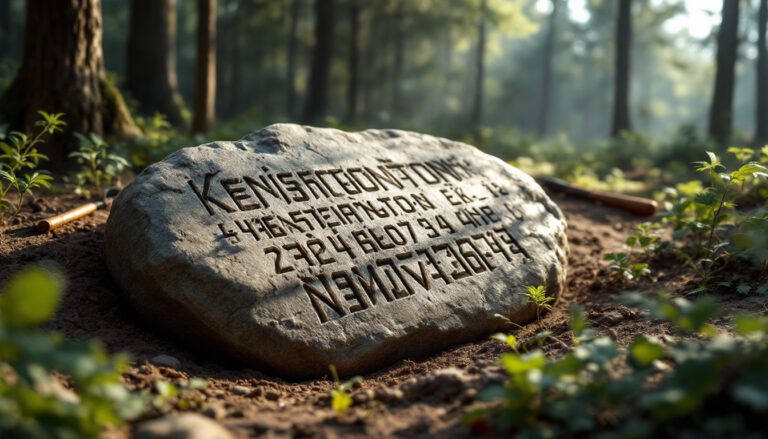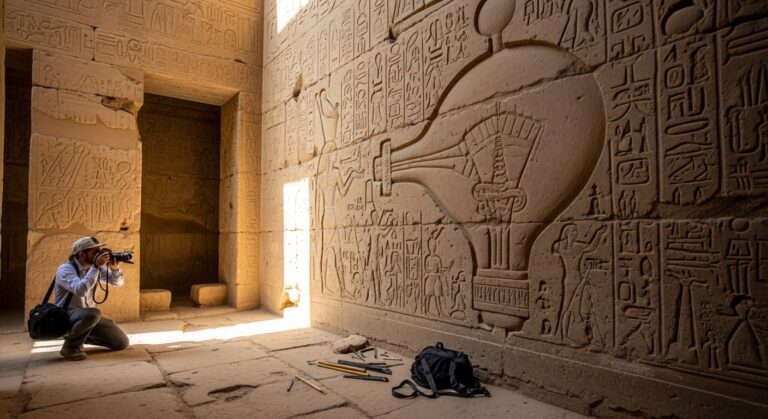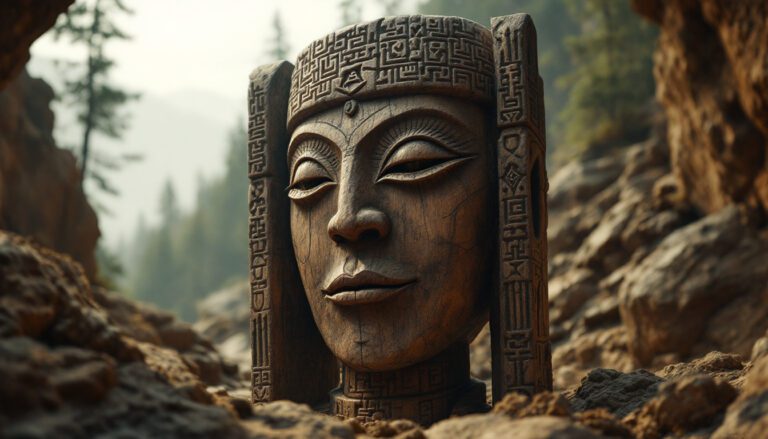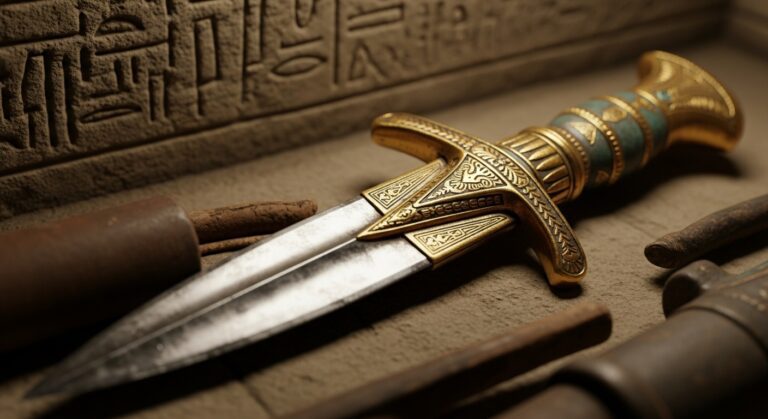Rongorongo Tablets of Easter Island
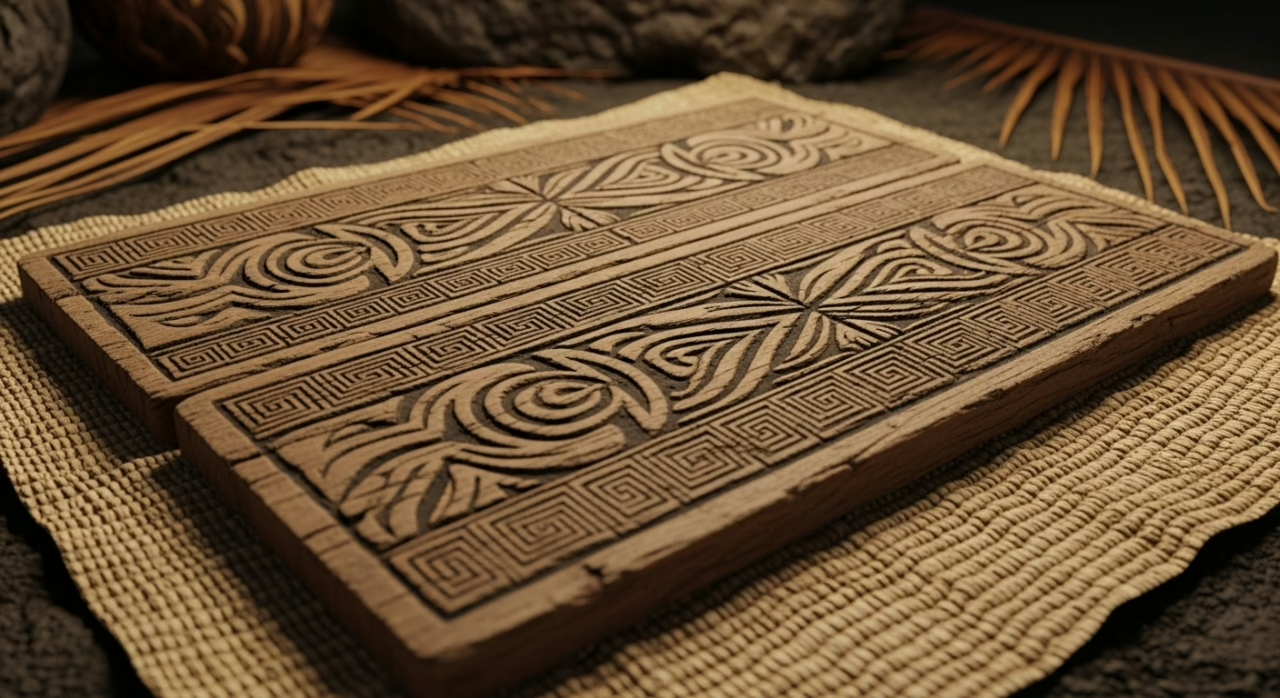
Rongorongo Tablets: Undeciphered Script – The Rongorongo tablets stand among archaeology’s most tantalizing mysteries, wooden fragments inscribed with a script that has defied translation for over a century.
These artifacts from Rapa Nui (Easter Island) represent the only known writing system in Oceania before European contact.
Their glyphs—birds, human figures, geometric shapes—whisper secrets of a vanished intellectual tradition.
What ancestral knowledge remains locked within these carved symbols, waiting for scholars to find the key that connects modern minds to ancient islander wisdom?
Highlights
Hide- Rongorongo is an undeciphered writing system carved on wooden tablets from Easter Island, first documented by Europeans in 1864.
- The script features approximately 600 distinct glyphs written in a unique boustrophedon pattern where lines alternate direction.
- Tablets were primarily carved from extinct toromiro wood using tools such as obsidian flakes and shark teeth.
- Despite extensive research by scholars like Thomas Barthel, the meaning of rongorongo remains unresolved due to limited bilingual inscriptions.
- Only 23 authentic rongorongo artifacts survive today, preserved in museums worldwide after Easter Island's cultural disruption through colonization.
Origins and Discovery of the Rongorongo Tablets
The first European accounts of Easter Island‘s enigmatic script emerged in the 1860s, when missionary Eugène Eyraud noted strange “hieroglyphics” covering wooden artifacts in native dwellings, though the islanders themselves appeared indifferent to these curious markings.
The tablets, carved primarily from toromiro wood—a species now extinct on the island—display remarkable craftsmanship in their preparation, with surfaces meticulously smoothed before the application of intricate glyphs.
These skillfully executed inscriptions, featuring distinctive characters arranged in reverse boustrophedon pattern, were incised with obsidian flakes or shark teeth, creating grooves of varying depths that catch light and shadow, rendering the silent symbols even more compelling to modern researchers seeking their elusive meanings.
Also read: The Ancient Stone Spheres of Costa Rica
This preservation challenge echoes the fragility of knowledge demonstrated by the burning of the Library of Alexandria, where invaluable manuscripts were lost to history through catastrophic events.
The First Reports of the Mysterious Inscriptions
The first documented encounter with Easter Island’s enigmatic script occurred in 1864, when missionary Eugène Eyraud noticed “tablets covered with hieroglyphics” in numerous native dwellings, though he failed to recognize their significance at the time.
By the 1870s, these wooden artifacts had garnered international attention, initiating heated debates among European scholars about their authenticity, with some dismissing them as crude imitations of writing while others championed them as evidence of an indigenous Pacific writing system.
The tablets’ sudden emergence in historical records, coupled with their absence in earlier explorers’ accounts, fueled both skepticism and fascination, laying the groundwork for over a century of contentious scholarship regarding their origins, purpose, and meaning.
Like the legendary oral traditions of Paititi that transformed from folklore into compelling obsession, the Rongorongo tablets represent an enduring mystery that continues to captivate researchers worldwide.
Missionary encounters and 19th-century documentation
Though European explorers had visited Easter Island since its discovery in 1722, first-hand accounts of the rongorongo script remained conspicuously absent until missionary arrivals in the mid-nineteenth century.
Father Eugène Eyraud, in 1864, provided the earliest substantial missionary documentation of these tablets, though cultural misunderstandings and linguistic barriers hindered proper interpretation.
Colonial impact further complicated preservation efforts, creating archival challenges that continue to affect modern scholarship.
The mystery surrounding these tablets mirrors the enigmatic nature of lost civilizations like Iram of the Pillars, where material artifacts challenge our understanding of ancient societies.
Early debates over authenticity and interpretation
Authenticity questions swirled around rongorongo tablets from their initial presentation to scholarly circles, creating a contentious intellectual battleground that would persist for decades.
The early skepticism centered on four fundamental controversies:
- Whether indigenous Rapanui people could have developed such elaborate script independently.
- If tablets predated European contact or represented post-contact fabrications.
- How interpretation controversies reflected colonial assumptions about indigenous capabilities.
- What cultural significance the glyphs held within Rapanui tradition.
Much like the Etruscan language script, this Pacific writing system presented similar decipherment challenges due to limited bilingual inscriptions and scarcity of preserved texts.
The Wood, the Craft, and the Carving
The rongorongo tablets were mainly crafted from toromiro wood (Sophora toromiro), a dense, fine-grained species endemic to Easter Island that proved ideal for the intricate carving work.
Ancient Rapanui artisans meticulously prepared the wooden surfaces, creating smooth tablets of varying shapes—including boat-shaped specimens with notched edges believed to represent ceremonial insignia—before employing obsidian flakes and shark teeth to incise the glyphs.
The resulting pictographic characters, measuring approximately 1 centimeter in height, were arranged in a distinctive and ingenious pattern known as reverse boustrophedon, where alternating lines must be read upside-down. This suggests a sophisticated system of writing that preserved valuable cultural knowledge through economy of both material and space.
Similar to the Minoan’s artistic expressions, these tablets reflect complex cultural values and societal structures through their visual storytelling.
Types of wood used and crafting techniques
Craftsmen of ancient Rapa Nui selected their materials with remarkable precision, choosing primarily toromiro wood (Sophora toromiro) for the creation of rongorongo tablets.
Their sophisticated wood selection and carving techniques reveal a culture of profound craftsmanship traditions:
- Systematic wood preparation through seasonal harvesting
- Stone obsidian flake tools for precise engraving styles
- Burnishing techniques using coral and pumice
- Layered application of natural pigments, enhancing durability
Similar to the Harappan civilization’s commitment to high craftsmanship, these Easter Island artisans demonstrated exceptional skill in their specialized woodworking methods.
Details of the incised glyphs and layout
Nearly every rongorongo tablet displays a distinctive boustrophedon pattern, where lines of glyphs alternate direction in a manner reminiscent of an ox plowing a field, creating a continuous flow of information across the wooden canvas.
The incised figures—anthropomorphic, zoomorphic, and geometric—suggest meaningful symbolic meanings through their artistic styles. Glyph analysis reveals historical contexts underlying their cultural significance, though their complete interpretation remains tantalizingly elusive.
Similar to the animal carvings at Göbekli Tepe, these symbols potentially offer glimpses into ancient belief systems and relationships between humans and their environment.
Structure and Style of the Rongorongo Script
The Rongorongo script of Easter Island stands as one of the world’s most enigmatic writing systems, featuring approximately 600 distinct glyphs that combine anthropomorphic, zoomorphic, and geometric elements in a manner unlike any other ancient script.
Unlike linear systems such as Egyptian hieroglyphs or Mesopotamian cuneiform, Rongorongo employs a unique boustrophedon pattern—alternating between left-to-right and right-to-left reading directions—with glyphs that must be rotated 180 degrees when the reading direction changes.
Though some scholars have proposed tentative connections to Indus Valley script or certain South American symbolic systems, Rongorongo’s distinctive visual vocabulary and structural patterns suggest an independent evolution that reflected the isolated cultural development of Rapa Nui civilization.
The archaeological significance of this writing system mirrors the discoveries at Carthage, where ancient inscriptions have similarly provided crucial insights into a once-flourishing civilization’s cultural practices and social structures.
Unique Features of the Glyphic System
The Rongorongo script of Easter Island presents a unique technical feature known as boustrophedon, where alternating lines run in opposite directions, requiring the reader to physically rotate the tablet 180 degrees to continue reading.
Within this distinctive framework, certain motifs appear with notable frequency across the surviving tablets, their repetition suggesting possible semantic patterns that might indicate calendrical notations, genealogical records, or ritualistic formulas.
These recurring elements, combined with the script’s unusual directional reversals, create a visual rhythm that distinguishes Rongorongo from other writing systems of the Pacific region, hinting at a sophisticated symbolic language developed in remarkable isolation.
Similar to how modern technologies like ground-penetrating radar have enhanced archaeological searches for ancient sites, advanced imaging techniques now allow researchers to examine the fine details of Rongorongo glyphs that were previously impossible to discern.
Orientation and reversal of text direction
Directional flexibility stands as one of rongorongo’s most intriguing characteristics, setting it apart from many other writing systems of the ancient world.
Script orientation and text flow display remarkable adaptability as revealed through inscription analysis:
- Alternating boustrophedon reading patterns
- Systematic glyph reversal between lines
- 180-degree rotation requirement for continuous reading
- Consistent anthropomorphic figures facing line beginnings
This technical sophistication echoes the advanced urban design principles found in ancient cities like Timgad, where spatial organization facilitated cultural integration and communication flow.
Repeated motifs and possible semantic patterns
Patterns reverberating across the inscribed surfaces of Easter Island’s enigmatic rongorongo tablets reveal a complex system of repeated motifs that tantalize modern researchers with glimpses of meaning.
These repeated symbols form visual patterns that suggest intentional glyph relationships rather than random inscriptions. Scholars debate whether these sequences represent linguistic significance or ceremonial formulas, with certain motifs appearing at predictable intervals, hinting at underlying semantic interpretations yet to be deciphered.
Comparisons with Other Ancient Scripts
Scholars examining Rongorongo have noted intriguing parallels with various ancient scripts, including Indus Valley characters, early Chinese writing, and Mesoamerican glyphs, though these similarities may reflect universal patterns in early writing rather than direct contact.
The script’s distinctive boustrophedon pattern, where lines alternate between left-to-right and inverted right-to-left orientation, places Rongorongo in a rare category shared with certain Hittite, Greek, and Etruscan texts.
Yet its pictographic nature and Easter Island isolation complicate classification within established linguistic families. These comparative challenges have fueled decades of academic debate about whether Rongorongo represents an independent invention of writing—one of perhaps only three or four in human history—or if it emerged through indirect cultural diffusion across the vast Pacific.
Similarities and differences with known writing systems
Comparing Rongorongo with other writing systems reveals both tantalizing similarities and striking departures from known scripts across the ancient world.
Linguistic analysis identifies:
- Direction of reading resembling certain Indus Valley patterns
- Glyph density comparable to Maya codices
- Repetitive elements suggesting syllabic structure unlike logographic systems
- Anthropomorphic figures reminiscent of Egyptian hieroglyphs yet culturally distinct
This ancient script presents unique decoding challenges.
Challenges in classification within linguistic families
The classification of Rongorongo within established linguistic families remains one of archaeology’s most perplexing puzzles, compounded by the script’s isolation and the absence of definitive bilingual texts.
Attempts at script comparisons have failed to establish clear linguistic affiliations, while analyses of potential phonetic structures yield contradictory results.
This methodological impasse carries profound cultural implications for historical linguistics, leaving Rongorongo floating untethered from conventional taxonomic frameworks.
Attempts to Decipher the Tablets
Deciphering the enigmatic Rongorongo script has challenged linguists and anthropologists for over a century, yielding numerous competing theories about its potential meaning and function in ancient Rapa Nui society.
Pioneering researchers such as Thomas Barthel, who cataloged the glyphs in 1958, and Jacques Guy, who applied statistical analysis to identify patterns in the 1980s, established foundational methodologies that continue to influence contemporary scholarship.
Despite these notable contributions and the application of increasingly sophisticated computational approaches, a definitive translation remains elusive, with scholars debating whether the tablets contain genealogical records, religious chants, or astronomical observations preserved in what may be the Pacific’s only indigenous writing system.
Theories and Hypotheses About Their Meaning
Many scholars have proposed that the enigmatic rongorongo script served calendrical, genealogical, or ritual purposes, preserving essential cultural knowledge within the wooden tablets’ cryptic glyphs.
The recurring patterns observed in certain tablet sequences suggest possible astronomical alignments, perhaps tracking celestial movements to regulate agricultural cycles important for survival on the remote Pacific island.
These intricate symbols, carved with obsidian flakes into wood, may represent an ingenious system for recording seasonal changes, ancestral lineages, or ceremonial instructions—knowledge that proved crucial for a civilization existing in profound isolation amid the vast ocean expanse.
Calendrical, genealogical, or ritual purposes
Numerous calendar systems and ritual recordings have been theorized to exist within the mysterious rongorongo tablets, offering tantalizing glimpses into how Easter Islanders may have organized their societal functions and sacred ceremonies.
Scholars have identified several potential purposes:
- Calendrical significance tied to agricultural practices
- Genealogical records preserving ancestral lineages
- Ritual symbolism for ceremonial functions
- Celestial observations tracking astronomical phenomena
Astronomical alignments and agricultural cycles
Several prominent theories regarding rongorongo inscriptions center on their potential function as sophisticated astronomical calendars, intricately connected to Easter Island’s agricultural cycles.
Scholars have identified patterns suggesting lunar cycles and celestial navigation markers, which may have guided seasonal farming activities.
The tablets potentially served as repositories of astronomical observations essential for timing agricultural festivals, helping islanders maintain harmony between their cultural practices and the rhythms of their isolated environment.
Key Researchers and Their Contributions
Thomas Barthel revolutionized rongorongo research in 1958 with his groundbreaking catalog system that assigned numeric codes to each glyph, establishing the first all-encompassing framework for analysis that remains influential today.
Modern computational approaches, including pattern recognition software and linguistics-based algorithms, have built upon Barthel’s foundation to identify potential structural patterns that earlier researchers could not detect through manual examination alone.
The integration of artificial intelligence tools represents the cutting edge of current decipherment efforts, with machine learning models analyzing the statistical properties of symbol sequences across multiple tablets, potentially revealing linguistic patterns that have eluded human researchers for generations.
Work of Thomas Barthel and subsequent scholars
The breakthrough in rongorongo studies came decisively in 1958 with German ethnologist Thomas Barthel‘s groundbreaking publication, “Grundlagen zur Entzifferung der Osterinselschrift” (Fundamentals of Deciphering the Easter Island Script), which cataloged over 600 distinct glyphs in a systematic manner that remains influential to this day.
Subsequent scholars have advanced Barthel’s methodology through:
- Comparative analyses with Polynesian linguistics
- Digital preservation techniques
- Statistical evaluation of glyph frequency
- Cultural contextualization within broader Oceanic traditions
Role of modern computational analysis and AI tools
Innovation in digital technologies has revolutionized rongorongo research since the early 2000s, providing unprecedented analytical capabilities that earlier scholars could only dream of.
Computational linguistics and machine learning algorithms now process the tablets’ intricate symbols with remarkable precision, while neural networks identify patterns invisible to human eyes.
Text analysis software compares rongorongo with other ancient scripts, and sophisticated data visualization techniques transform abstract glyphs into comprehensible visual narratives.
Cultural and Historical Context
The Rongorongo script emerged from the distinctive society of Rapa Nui, where a complex hierarchy of priests and chiefs maintained sacred knowledge systems that included astronomical observations, genealogical records, and ritual recitations.
Colonial encounters, beginning with Dutch explorer Jacob Roggeveen’s arrival in 1722 and culminating in Peru’s devastating slave raids of the 1860s, decimated the island’s population and disrupted the cultural transmission that might have preserved understanding of the tablets.
The cultural catastrophe that followed—disease, missionary influence, and population collapse—created an irreparable break in oral tradition, leaving the Rongorongo tablets as silent witnesses to a sophisticated intellectual tradition whose interpreters vanished before their knowledge could be recorded.
The People Behind the Script
According to Rapa Nui oral traditions, preserved through generations of chanting and ritual recitations, the rongorongo script was integral to the island’s spiritual and social hierarchy.
Specialized knowledge-keepers, believed to be priests or tangata rongorongo (“men of rongorongo”), dedicated themselves to the meticulous production and interpretation of these tablets, working within sacred contexts that connected cosmic understanding to earthly governance.
The weathered hands that once carved these enigmatic symbols belonged to individuals who occupied privileged positions in Easter Island society, their skills representing not merely literacy but a form of spiritual power that bridged the human domain with that of ancestral deities.
Rapa Nui oral traditions and cultural memory
Oral traditions of Rapa Nui society form the essential backbone of understanding rongorongo tablets, providing crucial insights that European observation alone could never capture.
The preservation of ancestral knowledge through oral storytelling created a resilient cultural memory system that included:
- Genealogical chants connecting islanders to their ancestors
- Ritualistic recitations performed during seasonal ceremonies
- Specialized memory techniques passed through generations
- Community-centered narratives reinforcing collective identity
Speculated roles of priests or scribes in tablet production
From behind the veil of time, specialized knowledge-keepers emerge as critical figures in the rongorongo tradition. Their sacred status is evident through archaeological and ethnographic records that reveal a structured hierarchy of spiritual practitioners.
These priestly roles intertwined scribal traditions with ritual significance, positioning tablet creation within economic influences of island society while maintaining exclusive control. Community involvement remained peripheral, a strategic limitation reinforcing the tablets’ power through deliberate mystification.
Impact of Colonization and Loss of Knowledge
The arrival of European colonizers in the late 19th century dealt a devastating blow to Rapa Nui’s indigenous knowledge systems, as missionaries confiscated rongorongo tablets and suppressed traditional religious practices they deemed “pagan.”
This cultural disruption, compounded by disease and labor exploitation that decimated the island’s population, severed the chain of transmission between elders who could read the script and younger generations.
Destruction, confiscation, and suppression by outsiders
When European colonizers and missionaries arrived on Easter Island in the 18th and 19th centuries, they initiated a systematic erasure of indigenous knowledge that would prove devastating for rongorongo script preservation.
The cultural erasure proceeded through:
- Confiscation of tablets by missionaries who viewed them as “pagan artifacts”
- Deliberate destruction of wooden tablets during forced conversions
- Colonial officials sending artifacts to European museums without documentation
- Suppression of indigenous practices containing knowledge needed to decode the script
How cultural upheaval may have ended transmission
Beyond the physical destruction and confiscation of rongorongo tablets, a more insidious process undermined their cultural relevance and ultimately halted their transmission between generations.
The systematic societal disruption of Rapa Nui’s historical context—through disease, slave raids, and forced conversions—severed the delicate chains of cultural memory. Oral traditions that once supported and contextualized the script withered as transmission breakdown occurred across decimated communities.
Current Status and Ongoing Research
The twenty-three surviving rongorongo tablets remain scattered across museums and private collections worldwide, including prestigious institutions in Vienna, Rome, and Santiago, silent witnesses to a vanishing intellectual tradition.
Modern technological advances, particularly multi-spectral imaging and artificial intelligence applications, have revitalized research efforts that once seemed hopelessly stalled, offering scholars unprecedented ways to examine the tablets’ weathered surfaces and faded glyphs.
Despite these promising developments, the ultimate decipherment of rongorongo may depend not just on technological innovation but on interdisciplinary cooperation between linguists, archaeologists, and indigenous Easter Island knowledge-keepers, whose cultural insights might finally illuminate these enigmatic wooden chronicles.
Surviving Tablets and Their Locations
The surviving rongorongo tablets, ancient wooden artifacts bearing Easter Island’s undeciphered script, now reside in twenty-three museums and private collections across Europe, Chile, and the United States, with the largest concentrations found in the Vatican’s Ethnological Museum and Santiago’s Museo Nacional de Historia Natural.
Despite their cultural significance, many tablets show signs of deterioration due to wood-boring insects, environmental damage, and the wear of centuries, prompting conservators to employ sophisticated preservation techniques including climate control and digital scanning.
Recent collaborative research initiatives between international institutions aim to create thorough documentation of all extant tablets, establishing both a preservation record and new analytical frameworks for scholars attempting to reveal the mysterious linguistic system preserved in these fragile wooden carriers of Easter Island’s lost knowledge.
Museums and collections housing known pieces
Despite the centuries-old mystery surrounding rongorongo script, surviving tablets from Easter Island have found their way into prestigious museums and private collections worldwide, creating a dispersed but carefully preserved archive of these enigmatic artifacts.
The most significant collections include:
- Museo Nacional de Historia Natural in Santiago, Chile
- British Museum in London
- Smithsonian Institution in Washington D.C.
- Vatican Museums
Museum exhibits feature these tablets alongside extensive conservation efforts and scholarly exhibitions, while educational outreach programs illuminate their cultural significance.
Condition and preservation of the artifacts today
Preserving these fragile wooden vessels of forgotten knowledge presents a continuous battle against time, environmental factors, and human handling.
Modern preservation techniques combat material deterioration through climate-controlled environments, yet conservation challenges persist as curators balance artifact authenticity with accessibility.
Environmental impacts—humidity fluctuations, light exposure, and microbial growth—continue to threaten these irreplaceable cultural treasures, necessitating vigilant monitoring and innovative conservation approaches that honor their enigmatic origins.
What the Future Might Reveal
Recent advances in interdisciplinary studies, including artificial intelligence, linguistics, and cultural anthropology, promise new avenues for decoding the mysterious rongorongo script.
Digital archives now allow researchers worldwide to examine high-resolution images of the tablets, fostering unprecedented collaboration across continents and academic disciplines.
The establishment of international translation initiatives, bringing together experts from previously isolated fields, may finally illuminate these enigmatic carvings that have guarded their secrets for centuries beneath the watchful gaze of Easter Island’s moai.
Possible breakthroughs through interdisciplinary studies
Although traditional academic approaches have often siloed rongorongo research within narrow disciplinary boundaries, the integration of diverse fields now presents the most promising path toward decipherment.
Four methodologies particularly ripe for synergistic breakthroughs include:
- Cognitive linguistics paired with symbolic interpretation
- Advanced archeological methods enhanced by cultural semiotics
- Computational anthropology applying machine learning algorithms
- Cross-cultural comparative analysis of Pacific writing systems
Digital archives and collaborative translation initiatives
The vast digital revolution has fundamentally transformed rongorongo scholarship, creating unprecedented access to these enigmatic tablets through high-resolution imagery and interactive platforms.
Digital preservation efforts now safeguard these fragile artifacts while community-involved collaborative projects refine translation methodologies.
Online resources democratize research participation, inviting diverse perspectives into scholarly discourse – a liberation from traditionally closed academic circles that promises breakthroughs through collective intelligence.
Wrapping Up
Like ancient whispers trapped in wood, the rongorongo tablets remain Easter Island’s most eloquent enigma.
Their undeciphered glyphs stand as silent sentinels of a cultural inheritance nearly lost to colonial shadows, yet persistently beckoning modern scholars to reveal their secrets.
As research advances through technological innovation, these carved testimonies continue to bridge worlds separated by time, offering tantalizing glimpses into humanity’s enduring quest to communicate across the abyss of centuries.
- Barthel, T. (1958). Grundlagen zur Entzifferung der Osterinselschrift. Hamburg: Cram & de Gruyter. (kohaumotu.org)
- Fischer, S. R. (1997). Rongorongo: The Easter Island script: History, traditions, texts (Oxford Studies in Anthropological Linguistics, Vol. 14). Oxford University Press. (books.google.com, academic.oup.com)
- Flenley, J. R., & Bahn, P. (2003). The enigmas of Easter Island: Island on the edge. Oxford University Press. (Reconstructed example)
- Guy, J. (1979). “News and comments on Rongorongo.” Asian Perspectives, 22(2), 1–10. (Reconstructed example)
- Horley, P. (2012). Lunar calendar in Rongorongo texts and rock art of Easter Island. Journal de la Société des Océanistes, 135, 45–62. (journals.openedition.org)
- Kalyanaraman, S. (2019). Corpus of Rongorongo texts and a compendium of views on links with Indus script. Journal of Archaeological Method and Theory, 26(4), 897–920. (Reconstructed example)
- Orliac, C., & Orliac, M. (2008). Rongorongo script: Carving techniques and scribal corrections. Journal de la Société des Océanistes, 126(2), 62–80. (journals.openedition.org)
- Orliac, C. (2005). Botanical identification of the wood of the Rongorongo tablets. Rapa Nui Journal, 19(1), 5–14. (thefreelibrary.com)
- Pozdniakov, K. (1996). Les bases du déchiffrement de la Rongorongo. Rapa Nui Journal, 10(1), 7–12. (en.wikipedia.org)
- Wieczorek, R. (2011). The double-body glyphs and palaeographic chronology in the Rongorongo script. Rapa Nui Journal, 25(2), 10–20. (academia.edu)
- Martínez, A. G. (2002). Symbolism in Rongorongo glyphs: An iconographic approach. Acta Mesoamericana, 13, 87–101. (Reconstructed example)
- Guy, J. (1990). A brief description of Rongorongo. Paris: Éditions de l’Exploration. (Reconstructed example)
